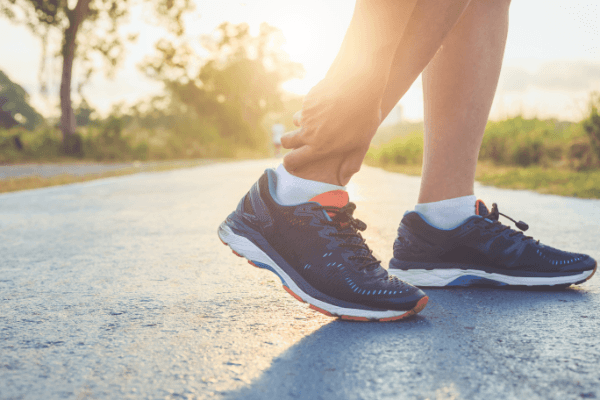
We are now several weeks into the lockdown amidst the COVID-19 pandemic. With gyms closed, there has been a large increase in people getting out of the house for their one allocated form of exercise a day (walking, running or cycling). For the majority of people in London, a commute to work will normally include these types of activities and form part of their daily exercise routine. However, it is likely that far more people are taking the opportunity to get out of the house and walk more regularly, or even start running.
Many people will stick to the same route each day, however some may look at trying to gradually increase distances, intensity or duration in order to improve fitness. As with any physical activity or sport this comes with risks and there is certainly no way to definitively prevent injuries occurring. The tree root you didn’t see while running in the woods, the kerb you mis-judged when stepping off the pavement, or that dip in the grass when walking in the fields are all common ways of rolling or spraining your ankle.
With hospitals busy treating patients with COVID-19 and the obvious anxiety that surrounds attending hospital with seemingly minor injuries, as well as the risk of contracting the virus, you can understand why minor injuries units and A&Es may not be seeing the same numbers of patients with trauma injuries. A reduction in contact sports will have helped reduce these numbers too. However, it should be understood that there is capacity for you to be seen should you suffer an injury that may need further urgent medical attention.
So what is the best way of managing an ankle sprain in these times?
What is an ankle sprain?
An ankle sprain most commonly occurs when the ankle plantar flexes (points) and inverts (turns in). This stretches the ligaments (which join bone to bone) on the lateral side of the ankle and can cause pain, swelling, bruising and instability. The ligaments can be stretched at varying grades depending on the severity of the injury. However they can also increase the load to the fibular bone, causing a fracture and in extreme cases this can dislocate the ankle.
Do I need to go to A&E or a minor injuries unit?
A more detailed approach is to follow the OTTAWA ankle rules, which can be found here.1
How can I manage an ankle sprain at home?
Very effectively!
What used to be termed ‘R.I.C.E’ (Rest, Ice, Compression, Elevation), has now been replaced with ‘P.OL.I.C.E’ (Protect, Optimally Load, Ice, Compression, Elevation):2
Protect:If there is significant pain with walking, then using crutches can help to offload the injured ankle until it becomes more comfortable to put weight through it.Chinese people and Chinese food being equated with coronavirus and therefore being avoided due to people’s perception that they are a contamination risk.
Optimally Load:Walk on it as soon as it is comfortable. Complete rest will reduce strength around the ankle; we know that strengthening helps the recovery.
Ice/Compression/Elevation: If the ankle is painful, crushed ice can be a very effective analgesic for pain. With swelling and injury to the ligament, there is likely to be some pain, however inflammation in the first few days is a sign that the body is healing and therefore the use of anti-inflammatories may counteract this. The use of tubey grips in combination with raising the ankle above the heart may aid in a reduction in swelling.
What can I do to get back to the activity I love doing?
Once the acute nature of the pain has settled, the optimal loading aspect of ankle sprain management is best advised by a physiotherapist.
It is common for there to be a loss of ankle range of motion following an ankle sprain. It is imperative that this is fully restored alongside strength and proprioception (your body’s coordination, or ability to sense where limbs are in space) before returning to activity/sport to help reduce the risk of the injury recurring.
Injury to ligaments will affect the proprioception around the ankle. Normally, people will report that they feel unsteady or have less control on the injured side; if this is not addressed fully it can lead to recurrent ankle sprains. Therefore exercises that challenge your balance progressively are often used as part of the rehabilitation programme.
If crutches have been used and activity levels have significantly reduced since the injury, muscle strength will also reduce as the muscles around the ankle won’t have been used as normal. Strengthening exercises can start quite early and can range from banded exercises to single-leg strengthening exercises that mimic the demands of the activity you are looking to return to.
How can I reduce the risk of this happening again?
Addressing range of motion, proprioception and strength with the guidance of a musculoskeletal physiotherapist will ensure that you can reduce the risk of spraining your ankle again.
With face-to-face consultations not currently taking place due to COVID-19, most musculoskeletal physiotherapists are running virtual consultations. These are proving to be effective in assisting with assessment and rehabilitation programming, using the space and equipment you have at home.
Following a structured rehabilitation programme, it is recommended to continue with strength and control exercises alongside your fitness routine to give you the best chance of reducing the risk of re-injury.
This article is for information only and should not be used for the diagnosis or treatment of medical conditions. myHealthSpecialist makes no representations as to the accuracy or completeness of any of the information in this article or found by following any link from this article. Please consult a doctor or other healthcare professional for medical advice.

James Lee, Specialist Musculoskeletal Physiotherapist
Book a telephone or video consultation with James Lee
Please note, during the current COVID-19 lockdown period, James Lee is only available to see NHS patients for free online consultations at Pure Sports Medicine: https://puresportsmed.com
However – other clinicians are available at Pure Sports Medicine for online consultations in our Virtual clinic. Call 020 4505 4808 or email
info@puresportsmed.com